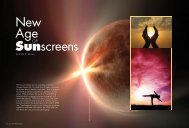By Linda W. Lewis - MedEsthetics
By Linda W. Lewis - MedEsthetics
By Linda W. Lewis - MedEsthetics
Create successful ePaper yourself
Turn your PDF publications into a flip-book with our unique Google optimized e-Paper software.
January/February 2009 | <strong>MedEsthetics</strong><br />
The growth of laser- and<br />
light-based procedures<br />
has not slowed the demand<br />
for effective topical<br />
treatments in the medical<br />
aesthetics industry. In fact,<br />
new ingredients and a growing<br />
recognition of the need for skin conditioning<br />
prior to and following cosmetic<br />
procedures are fueling an influx of new,<br />
physician-dispensed skincare lines into<br />
cosmetic practices. “Just as we see organic<br />
formulations gaining popularity in consumer<br />
cosmetics, we are also seeing major<br />
interest in science-based products,”<br />
says Sam Dhatt, MS, MBA, president<br />
and CEO of DermaQuest,<br />
Hayward, California. “I see<br />
specific growth in post-<br />
procedure skincare products<br />
that assist in wound healing<br />
after laser resurfacing or<br />
chemical peels.”<br />
<strong>By</strong> <strong>Linda</strong> W. <strong>Lewis</strong><br />
iStock.com
Skincare Trends<br />
XanGo<br />
Glimpse<br />
features green<br />
chemistry—cold<br />
processing of botanicals<br />
like mangosteen, a minimal<br />
carbon footprint in the manufacturing<br />
process, and a formulation free<br />
of chemicals known or strongly suspected of<br />
causing cancer or birth defects.<br />
Peptides continue to make news in<br />
skincare topicals. Jan Marini Age<br />
Intervention Peptide Extreme, for<br />
example, features four targeted<br />
peptide blends that work to rebuild<br />
and rejuvenate any skin type.<br />
X-Cellerate by Results Rx uses<br />
L-arbutin and AGP Complex to<br />
stimulate fibroblasts and even<br />
out skin tone to prepare skin<br />
for medical procedures.<br />
A complete pre- and post-procedure regimen available<br />
only through physicians’ offices, Clinique Medical uses<br />
patent-pending Probiotic Technology to improve the skin’s<br />
own defenses before treatments and to reduce inflammation<br />
immediately afterward. Innovative ingredients include<br />
hydrocortisone plus glyceritinic acid, which slows the<br />
breakdown of hydrocortisone and other anti-irritants.<br />
January/February 2009 | <strong>MedEsthetics</strong><br />
Clinique Medical, a joint venture of<br />
pharmaceutical giant Allergan and international<br />
cosmetic leader Clinique,<br />
is one of the most recent introductions<br />
aimed at physicians. The product line<br />
was designed for patients undergoing<br />
resurfacing procedures or other cosmetic<br />
treatments. Its patent-pending<br />
Probiotic Technology increases the<br />
skin’s own defenses with its proprietary<br />
Lactobacillus Ferment, which<br />
helps maintain the skin’s barrier with<br />
natural lipids and limits the risk of unintended<br />
effects of procedures. The<br />
Clinique Medical line includes Probiotic<br />
Cleanser, Skin Conditioning Treatment,<br />
Recovery Week Complex and Optimizing<br />
Treatment Cream. Another new key<br />
ingredient is tumeric root extract for<br />
correcting uneven skin tone and skin<br />
dyschromia.<br />
Physicians, including Vic Narurkar,<br />
MD, FAAD, board-certified dermatologist,<br />
director of the San Francisco Bay<br />
Area Laser Institute, and lead investigator<br />
in a study evaluating Clinique Medical<br />
in use with IPL and fractionated laser<br />
treatments, note that the focus on combining<br />
topical regimens with laser- and<br />
light-based services is likely a growing<br />
trend. “Until recently, there were no<br />
comprehensive skincare regimens designed<br />
specifically to complement in-office<br />
skin resurfacing treatments (i.e., using<br />
IPL or a fractional laser),” he says.<br />
Beverly Hills, California-based plastic<br />
surgeon Michael B. Stevens, MD, PhD,<br />
FACS, now offers his patients pre- and<br />
post-procedure topical care through the<br />
retinoic acid-based Obagi line. “Topical<br />
skincare should come first,” he says.<br />
“It’s cost effective, low risk and helps to<br />
improve skin condition for better outcomes,<br />
including quicker healing and<br />
reduced complications.”<br />
“As more physicians embrace the<br />
concept of offering patients one-stop<br />
shopping, more companies are offering<br />
lines exclusively for this market<br />
channel,” says cosmetic chemist John<br />
Kulesza, PhD, president of Young Pharmaceuticals.<br />
“And I believe patients love<br />
being able to find higher potency products<br />
in their doctors’ offices with better<br />
product information than they can find<br />
in traditional retail environments.”<br />
“We are seeing continued emphasis<br />
on physician-developed skincare lines<br />
at the retail level and in doctors’ offices—lines<br />
using technologies with sound<br />
“Until recently, there were no comprehensive<br />
skincare regimens designed specifically to<br />
complement in-office skin resurfacing treatments.”<br />
scientific support and measurable benefits,”<br />
agrees Barbara Green, RPh, MS,<br />
vice president, technology and clinical<br />
evaluations at The NeoStrata Company,<br />
Princeton, New Jersey. “NeoStrata, for<br />
example, is targeting regimen groupings<br />
in which a few products with complementary<br />
technologies are used together<br />
to deliver visible clinical results.”<br />
New Ingredients<br />
While science and results are emphasized<br />
in lines directed at medical practices,<br />
physician-dispensed lines are<br />
also continuing to trend toward pure<br />
and natural ingredients. “It actually<br />
started seven or eight years ago,” notes<br />
Howard Murad, MD, a dermatologist<br />
and founder of Murad Inc., El Segundo,<br />
California, “with a surge in ethnobotany—herbs/foods<br />
grown in specific<br />
habitats that were found to be high in<br />
specific chemicals, such as pomegranates<br />
from North Africa, which proved
Skincare Trends<br />
Murad aims to give new<br />
meaning to “beauty sleep”<br />
with its Sleep Reform Serum<br />
and Supplements designed<br />
to help the skin “sleep” with<br />
gamma-aminobuyteric acid to<br />
encourage muscle relaxation,<br />
methyl-sylfonimethan to reduce<br />
inflammation, and body and<br />
skin relaxing melatonin in the<br />
supplement and the topical.<br />
GliSODin Skin<br />
Nutrients’ new line<br />
confirms the trend<br />
toward inside-out<br />
skin health.<br />
Retinols continue to<br />
set the standard for<br />
well-researched product<br />
ingredients. Procyte’s<br />
new NEOVA Matrix AR<br />
contains patented<br />
retinol technology.<br />
January/February 2009 | <strong>MedEsthetics</strong><br />
to be especially effective at preventing<br />
and treating sun damage.”<br />
As the century turned, antioxidants<br />
became all the rage: Green tea, gogiberry,<br />
Revaleskin’s CoffeeBerry and other<br />
botanical extracts showed significant<br />
effects when tested in vitro and in some<br />
limited in vivo studies.<br />
“Our latest find is durian extract<br />
from Southeast Asia,” says Dr. Murad.<br />
“It contains numerous fatty acids, as<br />
well as other valuable fruit acids. We<br />
use it in Durian Cell Reform to increase<br />
cell turnover and provide intensive hydro<br />
protection.”<br />
Another new antioxidant is BioActive<br />
X 3 Complex, which is found in Glimpse<br />
Intuitive Skin Care from XanGo, a global<br />
nutrition company. The complex, which<br />
uses mangosteen extract, combines<br />
three exclusive xanthone-rich ingredients<br />
that, according to Japanese in vitro<br />
studies, contain 30 times more antioxidant<br />
potency than green tea. The study<br />
also indicated anti-inflammatory action<br />
and collagen stimulation.<br />
“Peptides are still a growing segment<br />
in the industry, as well,” says<br />
Dhatt, “and I don’t see this trend slowing<br />
down anytime soon. If peptides can<br />
be delivered into the skin, with their<br />
smaller molecular size and assisted delivery<br />
systems, they can mimic many<br />
skin functions without irritation, which<br />
is extremely compelling in cosmetic science.<br />
There are also peptides that stimulate<br />
the body’s own growth factors,<br />
which can potentially replace using<br />
growth factors from human sources.”<br />
Skin growth factors and ingre-<br />
dients meant to stimulate them constitute<br />
another major skincare trend.<br />
In a review of cosmeceutical agents<br />
published in the July 2008 isssue of<br />
Clinical Medicine: Dermatology<br />
(Libertas Academica), Thomas C. Tsai<br />
and Basil M. Hantash, MD, PhD from<br />
the Program for Regenerative Medicine<br />
at Stanford University School of<br />
Medicine, Stanford, California, define<br />
growth factors as “large proteins that<br />
are synthesized by a variety of cells in<br />
the body and play an important role in<br />
the regulation of immunity, cell division,<br />
wound healing and tissue regeneration.”<br />
They report that TNS Recovery<br />
Complex (SkinMedica) has shown<br />
some interesting results but needs to<br />
be tested in controlled studies, as have<br />
“If peptides can be delivered into the skin, with<br />
their smaller molecular size and assisted delivery<br />
systems, they can mimic many skin functions<br />
without irritation.”<br />
Citrix CRS Cream (Topix Pharmaceuticals)<br />
and Pal-KTTKS (P&G Beauty).<br />
Since the size of growth hormone<br />
proteins makes them largely unsuitable<br />
for topical treatments, many formulators<br />
are working with short-sequence<br />
peptides (oligopeptides) containing<br />
the receptor binding motif of specific<br />
growth-factor proteins instead.<br />
“Growth-factor stimulators aren’t really<br />
new; we’ve had them in our products<br />
for at least five years,” says Dr.<br />
Murad. But they are just now becoming<br />
a marketing trend with lots of companies<br />
using the term. The Murad Professional<br />
line features proprietary Immuno-Skin<br />
Complex, a sequence of biopeptides<br />
formulated to strengthen skin immunity<br />
and stimulate the growth factors that<br />
regulate dermal matrix remodeling.<br />
The TNS Recovery Complex, which
Skincare Trends<br />
was introduced in August 2007, has<br />
found an enthusiastic following in<br />
medical aesthetic practices. It contains<br />
vascular endothelial growth factor,<br />
transforming growth factor (TGF)beta-1<br />
and soluble collagen and matrix<br />
proteins. Manufacturer studies show it<br />
promotes collagen synthesis, blood vessel<br />
formation, and fibroblast and keratinocyte<br />
proliferation.<br />
Topix Citrix CRS Cream with human<br />
growth factor TGF-beta-1 stimulates<br />
collagen growth and strong tissue structure.<br />
The CRS delivery system ensures<br />
vitamin C and TGF-beta-1 stability while<br />
enhancing penetration. A study done by<br />
Mitchell Goldman, MD, showed that after<br />
60 days, patients experienced a 30%<br />
increase in collagen and a 50% decrease<br />
in lines and wrinkles.<br />
In September 2008 Senetek introduced<br />
Pyratine-6, which it dubbed<br />
“revolutionary cytokinin-based skincare.”<br />
The company says the new technology<br />
works faster than kinetin to<br />
reduce roughness and redness. Jerry<br />
L. McCullough, MD, et al. published an<br />
independent study on Pyratine-6 in the<br />
February 2008 issue of Journal of Drugs<br />
in Dermatology. Dr. McCullough concluded,<br />
“Treatment with Pyratine-6<br />
(0.1%) over 12 weeks showed improvement<br />
in roughness and skin moisturization<br />
in two weeks and hyperpigmentation<br />
and fine wrinkles in four weeks.” Adverse<br />
effects were minimal and transient.<br />
In October 2008, San Diego-based<br />
Histogen, which calls itself a regenerative<br />
medicine company, announced a<br />
new cosmeceutical venture, Histogen<br />
Aesthetics. Headed by Lawrence A.<br />
Rheins, PhD, the company is developing<br />
a line of products based on its ReGenica<br />
Complex launched in early 2009 and<br />
distributed exclusively via physicians’<br />
offices. ReGenica is formulated with<br />
neonatal foreskin cells treated with enzymes<br />
and nutrients, which are maintained<br />
in an “embryonic-like state.” As<br />
the cells in the culture grow, they release<br />
growth factors and extracellular<br />
matrix into the vitamin mixture. The<br />
January/February 2009 | <strong>MedEsthetics</strong><br />
final product is an aqueous solution<br />
containing a complex mixture of actives<br />
such as keratinocyte growth factor,<br />
soluble human collagen and natural<br />
cellular antioxidants. The mimicking of<br />
in utero conditions provides the correct<br />
microenvironment for these cells<br />
to produce extracellular insoluble and<br />
soluble factors.<br />
“What I like is that we are not adding<br />
outside growth factors; we’re working<br />
with the skin’s own physiology,” says<br />
Rheins. “Most dermatology problems<br />
have a base of chronic inflammation,
Skincare Trends<br />
and this technology will address that.”<br />
The company is distributing the line<br />
through dermatologists and plastic<br />
surgeons “because we want their feedback,”<br />
says Rheins.<br />
Also introduced in October 2008,<br />
Estée Lauder’s new Time Zone Line<br />
features sirtuins, which the company<br />
calls “the next big thing” in antiaging<br />
skincare products. In “Sirtuins: A<br />
Breakthrough in Antiaging Research”<br />
(Cosmetics & Toiletries, January 2008)<br />
by Isabelle Imbert, PhD, et. al., from<br />
ISP Global Skin Research Center in<br />
Sophia Atipolis, France, the researchers<br />
explore the latest literature on this<br />
“recently discovered family of proteins”<br />
and conclude that cells where SIRT1<br />
was induced with an appropriate SIRT1<br />
expression optimization activating compound<br />
(STAC) show a decrease in cell<br />
senescence; overall studies suggest that<br />
“SIRT1 expression optimization is an<br />
important strategy in the fight against<br />
aging,” say Imbert, et al. The Estée<br />
Lauder Time Zone Line combines its<br />
Sirtuin EX-1 compound with Tri-Hyaluronic<br />
Acid Technologies, which contain<br />
high molecular weight hyaluronic<br />
acid, hyaluronic acid fragments and<br />
anti-hyaluronidase technology to revive<br />
aging skin, and plump and tone it with<br />
optimum hydration.<br />
“The bottom line is that while it’s<br />
nice when an expensive skincare product—and<br />
human growth factors are<br />
expensive—appears more effective<br />
than a placebo, it must be compared<br />
to a retinoid to assess its true efficacy,”<br />
says Young Pharmaceutical’s Kulesza of<br />
growth factors in skincare formulations.<br />
“Retinoids are unquestionably safe and<br />
effective for the treatment of photoaging.<br />
Any manufacturer of a product<br />
claiming to treat photoaging must ultimately<br />
compare its product to a retinoid<br />
and, so far, I’m not seeing that done. I<br />
do think the SIRT-1 research is exciting;<br />
however, I am not convinced that any<br />
of the present ingredients claiming to<br />
mediate SIRT-1 activity have been sufficiently<br />
validated.”<br />
January/February 2009 | <strong>MedEsthetics</strong><br />
Recent ReseaRch<br />
“New ingredients are introduced every<br />
day from around the globe, and data or<br />
information on ingredients is presented<br />
in a wide variety of ways, sometimes<br />
making it difficult to understand the<br />
findings and how they translate into<br />
cosmetic skin benefits,” explains Laura<br />
J. Goodman, MS, P&G Beauty Science.<br />
“Ingredients are tested in the laboratory<br />
in what we call a ‘simple vehicle’<br />
(dissolved in water or another solvent)<br />
or ‘formulation’ (in a cream or gel).<br />
Ingredients can be evaluated in vitro<br />
or in vivo. Occasionally, in vitro test<br />
results can predict how an ingredient<br />
will perform in vivo, but not always.<br />
There are many steps between discovering<br />
a new ingredient and ensuring that<br />
it is in a formulation that allows for<br />
safe, effective delivery into the skin.<br />
It is important to understand how an<br />
ingredient has been evaluated and what<br />
safety testing has been done on it.<br />
“As you gather information on new<br />
ingredients and products, I recommend<br />
asking for claims substantiation. Claims<br />
substantiation documents should<br />
inform you about what testing has been<br />
done and how particular claims on the<br />
ingredients or products are supported.”<br />
You can also look for published studies.<br />
Below is a compilation of some of<br />
the research published in peer-reviewed<br />
journals or presented at major professional<br />
meetings since our previous<br />
skincare trends article that was written<br />
in August 2007. They are presented by<br />
date, with the most recent first.<br />
T Biro, MD, PhD, et al., Role of endocannabinoids<br />
in skin health, FASEB J, October 2008<br />
CD Mnich, et al., Green tea extract reduces induction<br />
of p53 and apoptosis in UVB-irradiated human<br />
skin independent of transcriptional controls,<br />
Exper Dermatol, October 2008.<br />
JC Murray, MD, et al., A topical antioxidant<br />
solution containing vitamins C and E with ferulic<br />
acid protects human skin from sunlight damage<br />
and DNA mutations associated with skin cancer,<br />
presented at The Academy for Investigative<br />
Dermatology, October 2008.<br />
BS Park, et al., Adipose-derived stem cells and<br />
their secretory factors as a promising therapy for<br />
skin aging, Dermatol Surg, October 2008.<br />
JM Crowther, et al., Measuring the effects of topical<br />
moisturizers on changes in stratum corneum<br />
thickness, water gradients and hydration in vivo,<br />
Brit J Dermatol, September 2008.<br />
TC Tsai and BM Hantash, MD, PhD, Cosmeceutical<br />
agents: a comprehensive review of the literature,<br />
Clin Med: Dermatol, July 2008.<br />
EB Souto and RH Muller, Cosmetic features and<br />
applications of lipid nanoparticles (SLN, NLC), Int<br />
J Cosmetic Sci, June 2008.<br />
C Barba et al., Cosmetic effectiveness of topically<br />
applied hydrolysed keratin peptides and lipids<br />
derived from wool, Skin Res and Tech, May 2008.<br />
GJ Fisher et al., Fibroblast collapse and therapeutic<br />
implications, Arch Dermatol, May 2008.<br />
BA Green, et al., Antiaging effects of topical lactobionic<br />
acid: results of a controlled usage study,<br />
Cosmet Dermatol, February 2008.<br />
C Millikin, et al., Additive benefits of the cosmetic<br />
ingredients niacinamide and N-acetyl glucosamine<br />
towards the in vitro regulation of melanin<br />
production, presented at the World Congress of<br />
Dermatology, October 2007.<br />
MK Robinson, et al., Immune and inflammatory<br />
gene expression profiles of chronological (intrinsic)<br />
skin aging and photoaging, presented at the World<br />
Congress of Dermatology, October 2007.<br />
DL Bissett, et al., Topical niacinamide formulations<br />
reduce the appearance of facial skin redness<br />
while formulation or other nicotinates induce<br />
skin flushing, presented at the World Congress of<br />
Dermatology, October 2007.<br />
R Osborne, et al., In vitro skin structure benefits<br />
with a new antiaging peptide, Pal-KT, presented at<br />
the World Congress of Dermatology, October 2007.<br />
KE Burke, Interaction of vitamins C and E as better<br />
cosmeceuticals, Dermatol Ther, September 2007.<br />
RC Mehta and FE Fitzpatrick, Endogenous<br />
growth factors as cosmeceuticals, Dermatol Ther,<br />
September 2007.
Skincare Trends<br />
“DNA repair ingredients and nonhuman<br />
based stem cell technology<br />
are also of interest in today’s antiaging<br />
skincare market, and this segment will<br />
continue to grow,” predicts Dhatt, who<br />
says that one of the most interesting new<br />
ingredients he has come across in a long<br />
time is PhytoCellTec Malus Domestica<br />
(apple stem-cell extract). Introduced by<br />
a Swiss company, Mibelle Biochemistry,<br />
in February 2008, and studied in the U.S.<br />
by Gary Goldfaden, MD, a clinical dermatologist<br />
in Hollywood, Florida, it is a liposomal<br />
preparation of stem cells from the<br />
Uttwiler Spätlauber apple, a tannin-rich<br />
variety that has unique storage longevity.<br />
A patent-pending plant cell culture<br />
technology was developed to cultivate<br />
dedifferentiated callus cells. Company<br />
in vitro studies have shown that PhytoCellTec<br />
Malus Domestica protects<br />
the longevity of skin stem cells, delays<br />
senescence of essential cells, combats the<br />
signs of chronological aging and regenerates<br />
the skin. A small human trial showed<br />
a 15% reduction in wrinkle depth after<br />
four weeks of use.<br />
What’s Next?<br />
Most of the ingredients and formulations<br />
introduced in the past year are<br />
relatively untested and their true value<br />
is yet to be determined. “New research<br />
on skin actives depends largely on having<br />
reliable screening assays to study<br />
effects on skin. As more sophisticated<br />
assays are available, companies will<br />
better understand the effects of their<br />
ingredients on skin and understand how<br />
to optimize complementary or synergistic<br />
effects,” says Green. For example,<br />
the presentation by Murray et al. (see<br />
“Recent Research” on page 36) on a<br />
topical antioxidant solution containing<br />
vitamins C and E with ferulic acid<br />
employs a more advanced antioxidant<br />
screening model that demonstrates the<br />
usefulness of a material in helping to<br />
prevent damaging DNA mutations following<br />
UV exposure. NeoStrata is working<br />
on similar research with some of its<br />
newer patented antioxidant materials.<br />
January/February 2009 | <strong>MedEsthetics</strong><br />
Innovations in skin care can come from<br />
discovering useful new properties of botanicals<br />
or other chemical combinations,<br />
but often they come from a study of the<br />
human body itself. Murad Inc. continues<br />
to create new products based on Dr.<br />
Murad’s research into the role water loss<br />
plays in cell health and how to strengthen<br />
cell walls and prevent cellular dehydration<br />
and impaired function. “The human body<br />
is the source of all kinds of useful chemicals<br />
that we can unlock under appropriate<br />
circumstances,” says Dr. Murad. z<br />
<strong>Linda</strong> L. <strong>Lewis</strong> is the executive editor of<br />
<strong>MedEsthetics</strong>.





